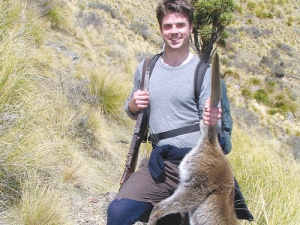Competition snares over 33,000 wild goats
The National Wild Goat Hunting Competition has removed 33,418 wild goats over the past three years.
 Hunter Jeremy Jones with a wallaby shot near the Studholme Hut in the Hunter Hills, South Canterbury, in 2015. Photo: Grant Morriss.
Hunter Jeremy Jones with a wallaby shot near the Studholme Hut in the Hunter Hills, South Canterbury, in 2015. Photo: Grant Morriss.
A multi-agency effort is gearing up to combat the spread of feral wallabies south of the Waitaki River.
A trial of a helicopter-borne thermal camera is due to start this month to try to estimate the numbers, amid concerns the pest is spreading naturally and by deliberate release.
Bennett's wallabies were introduced to South Canterbury for recreational hunting in the 19th century. Well established especially in the Hunter Hills area, between Waimate and the Waitaki River, they are now moving south.
Bruce Warburton, Landcare Research's wildlife ecology and management research team leader at Lincoln, says breeding populations of Bennett's wallabies are "probably" now established south of the river. They must go, if Environment Canterbury is to contain them north of the river as it has proposed.
"For those individual farmers there, wallabies compete with livestock, but it depends on the density of them and they're probably not in very high numbers," Warburton told Rural News. "But if you don't control them now they'll keep spreading and build up in number, so you've got to try to remove those new outlier populations."
Mark Giles, owner of the Hunter Hills Station in the Hakataramea Valley, north of the Waitaki, says wallaby numbers are not increasing everywhere.
"In the historical areas for wallabies – like our place – it's probably no worse than it's ever been. In fact, right at the moment, we're probably as low as we've been for a while, because we've managed it reasonably well."
Landowners are usually required to control wallaby numbers themselves and may be issued with compliance notices if inspections show populations on the rise. Shooting on the ground or from helicopters, and poison baits, are the usual killing methods.
Warburton is leading a project, expected to start this week, trialling an aerial thermal imaging camera to try to gauge numbers on the south side of the river.
The habitat consists of low matagouri scrub and tall tussock so the animals have cover and are hard to spot from a helicopter, but he hopes the thermal camera will locate them.
Some regions have recently been covered by hunters on the ground recording their tracks by GPS, and the camera will fly their tracks.
"If they've gone through that area and they've spent X hours hunting and they've managed to get, say, 10 wallabies; and if we fly it in 15 minutes and we see 50 wallabies, then we will know the thermal imaging is [better] at detecting wallabies," says Warburton.
"It's a pilot trial to see whether this new technology is of benefit and might help."
Warburton says in their traditional range it is not hard to see "hundreds" of wallabies.
"The problem is at the margin, where they are spreading at low density. They're the ones you need to find and get rid of. That's what's challenging because you can do a lot of looking and you may not see any but that doesn't mean they're not there."
Numbers south of the Waitaki had been in single digits for several years, but they jumped suddenly to 30, 33 and 25 in 2013, 2014 and 2015 respectively, and 10 so far this year.
Warburton warns against reading too much into the figures, however.
Meanwhile the Otago Regional Council is calling for vigilance to prevent the wallabies' southward spread.
ORC director of environmental monitoring and operations, Scott MacLean, says that while breeding populations are now reckoned established south of the Waitaki, they are not yet thought to be breeding south of the Hawkdun Range, the boundary between the ECan and ORC territories.
But he says wallabies have recently been seen in and around Oamaru and other parts of North Otago, far enough away from South Canterbury to suggest they were "clearly, illegally released".
"It is extremely disappointing to think that someone may be illegally releasing wallabies, given [they may harm] the rural economy and local biodiversity."
Warburton says the Waitaki south bank populations were probably due to unassisted spread, by animals crossing bridges or dams. But some spread is clearly human-assisted, he says. Hunters might take a joey home rather than kill it, or may be trying to establish local populations to hunt.
MacLean says the Otago pest management plan requires the public to report wallaby sightings and destroy animals if possible.
According to the latest Federated Farmers banking survey, farmers are more satisfied with their bank and less under pressure, however, the sector is well short of confidence levels seen last decade.
Farmer confidence has taken a slight dip according to the final Rabobank rural confidence survey for the year.
Former Agriculture Minister and Otaki farmer Nathan Guy has been appointed New Zealand’s Special Agricultural Trade Envoy (SATE).
Alliance Group has commissioned a new heat pump system at its Mataura processing plant in Southland.
Fonterra has slashed another 50c off its milk price forecast as global milk flows shows no sign of easing.
Meat processors are hopeful that the additional 15% tariff on lamb exports to the US will also come off.

OPINION: The release of the Natural Environment Bill and Planning Bill to replace the Resource Management Act is a red-letter day…
OPINION: Federated Farmers has launched a new campaign, swapping ‘The Twelve Days of Christmas’ for ‘The Twelve Pests of Christmas’ to…